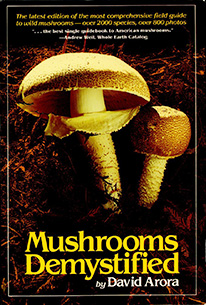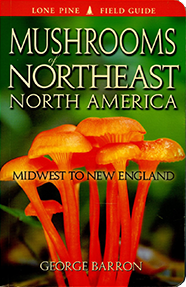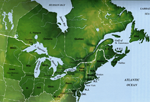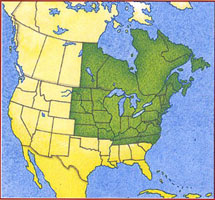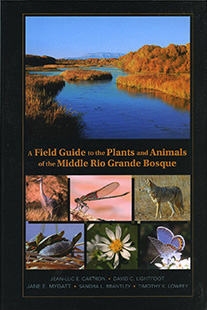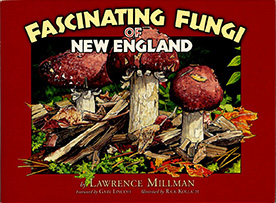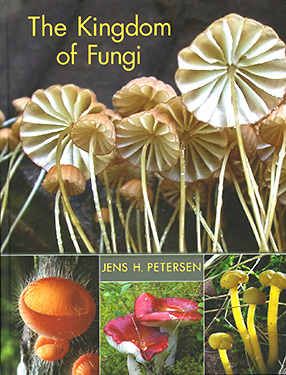
Mushrooms Bibliography

|
|
This bibliography covers fungi—mushrooms, “toadstools,” puffballs, gel fungi, stinkhorns, and slime molds. Note: book cover sizes in the list below are shown relative to each other. The list is organized by primary author. Some out-of-copyright books are available free at the supplied links. |
|
Author(s): Arora, David Publisher: Ten Speed Press, 1986 ISBN: 978-0898151695 View at: Barnes & Noble, or Amazon Comments: This 959-page guide is the most comprehensive I have seen, describing over 2,000 species in detail. The book contains a section of color photos in the center, with many more black & white photos throughout. Spore prints and chemical tests are provided. If you get serious about fungi, this guide is a must. Other guides are better suited for beginners though. |
Covers the United States and Canada. |
|
Mushrooms of Northeast North America Author(s): Barron, George Publisher: Lone Pine Publishing, 1999 ISBN: 978-1551052014 View at: Barnes & Noble, or Amazon Comments: Describes 609 species of mushrooms and slime molds, organized by groups. Includes a photo key at the beginning, dichotomous keys, and extensive color photographs. Contains 336 pages and 875 color photos. |
|
|
Mushrooms of Northeastern North America Author(s): Bessette, Alan E., Bessette, Arleen R., Fischer, David W. Publisher: Syracuse University Press, 1997 ISBN: 978-0815603887 View at: Barnes & Noble, or Amazon Comments: This book describes nearly 1500 species, with 650 color photos. It includes detailed keys that are written to be readable by ordinary mortals, not just botanists steeped in Botanical Latin. Photos are grouped into sections rather than included with the individual descriptions—a benefit when browsing images for possible matches, but not when browsing descriptions. 582 pages. |
|
|
Mycophilia: Revelations from the Weird World of Mushrooms Author(s): Bone, Eugenia Publisher: Rodale Books, 2011 ISBN: 978-1609619879 Comments: I really enjoyed this book. The author relates her developing infatuation with mycology, the study of fungi. I think she coined the term “mycophilia.” Her writiing is lucid, funny, ireepressibly enthusiastic, and not overly technical. 368 pages. |
|
|
A Field Guide to the Plants and Animals of the Middle Rio Grande Bosque Author(s): Cartron, Jean-Luc E.; Lightfoot, David C.; Mygatt, Jane E.; Brantley, Sandra L.; Lowrey, Timothy K. Publisher: University of New Mexico Press, 2008 ISBN: 978-0826342690 View at: Barnes & Noble, or Amazon Comments: This volume has the ambitious goal of capturing a broad swath of life along the Rio Grande. It discusses the settings and their environmental histories, habitat types, and places to visit. It covers nonvascular plants such as lichens and fungi; vascular plants (flowering and spore-producing); invertabrate animals; and amphibians, reptiles, birds, and mammals. The section on plants makes up about a quarter of the book. It is organized by family. Blooming period is featured prominently, a good idea, since we tend to notice plants in bloom. Also included is identifying information, natural history, and whether a species is threatened. There are about three species per page, so photos tend to be smaller than with some layouts. 375 pages. |
From the back cover: “Extending from the spillway below Cochiti Dam, about fifty miles north of Albuquerque, to the headwaters of Elephant Butte Reservoir, near Truth or Consequences in the southern portion of New Mexico, the Middle Rio Grande Bosque is more than a cottonwood woodland or forest.” |
|
Author(s): Miller, Jr., Orson K. Publisher: E.P. Dutton, 1979 ISBN: 978-0525474821 Comments: Covers more than 680 species, with full descriptions of 422. Includes identifying dichotomous keys; large, clear photos; detailed descriptions. The 368-page book also includes edibility information. There was probably an outer cover on this book originally. |
Covers the continental United States and Canada. |
|
Fascinating Fungi of New England Author(s): Millman, Lawrence Publisher: Kollath+Stensaas Publishing, 2011 ISBN: 978-1936571017 Comments: This wonderful nontechnical book illustrates many representative New England fungi with superbly executed color drawings. This book isn’t as comprehensive as some others, but it is a great way to become comfortable with classes of fungi, whether your goal is collecting, foraging, or simply admiring them. 134 pages. |
New England |
|
Author(s): Petersen, Jens H. Publisher: Princeton University Press, 2012 View at: Barnes & Noble Comments: This is the most beautiful presentation of fungi that I have so far had the pleasure of encountering. Stunning is not a powerful enough word to describe both the technical usefulness and aesthetic delight of these photos. Interspersed among the photos are readable, non-technical descriptions of how fungi go about their business. This is not a field guide, but it is a compelling view into an alien-seeming universe that lies all around us. |
|
|
Mushrooms and Other Fungi of North America Author(s): Phillips, Roger Publisher: Firefly Books, 2010 ISBN: 978-1554076512 View at: Barnes & Noble, or Amazon Comments: This interesting 319-page book takes a different approach to photographing the mushrooms. Each species is represented by multiple photos of specimens at different stages of growth, uprooted to show underground features, with cross sections and undersides. Scientifically detailed text descriptions accompany the numerous photos. |
Covers the United States. |
|
The North American Guide to Common Poisonous Plants and Mushrooms Author(s): Turner, Nancy J.; von Aderkas, Patrick Publisher: Timber Press, 2010 ISBN: 978-0881929294 Comments: It isn't often when an academic treatise is approachable enough to read from cover to cover, but I found that to be the case here. The authors cover mushrooms in detail, as well as other plants. They include coverage for some molds, some toxic algae, lichens, ferns—about 300 species in all. Descriptions for identifying these species are thorough, often accompanied by photos. They also describe symptoms, toxic agents, and treatment protocols. The discussion encompasses not only human poisoning, but plants that are toxic to pets and livestock. This is a very useful addition to any forager's library, as well as a helpful tool to those who treat victims of poisoning. 375 pages. |
North America |
